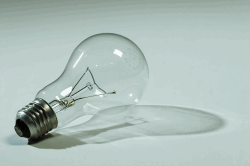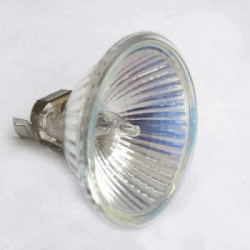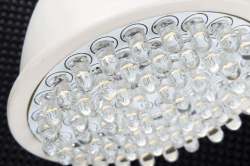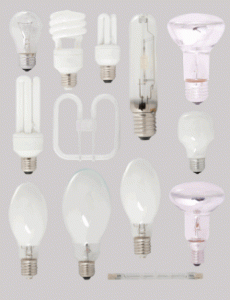Light Bulb Types: Color, Energy-Efficiency and Safety
Choose light bulb types that suit your lighting and home energy needs.
There is a large variety of light bulb types on the market today. The cost, light quality and safety quality of these types are widely varied, and it is an important part of any lighting design to understand the types and their strengths and weaknesses. Mistakes can lead to poor use of color, areas that are too bright or too dim and higher energy costs.
The different types of light bulbs ultimately vary in just a few areas, each of which needs to be taken account of in lighting decisions:
- Color: Even “white” lights are rarely white. They usually highlight certain color choices such as reds, blues, yellows and even greens.
- Energy Efficiency: An energy-saver light bulb is a light bulb that can deliver more light per watt than other bulbs. The more light per watt a bulb produces, the more efficient it is.
- Safety: Different types of light have different safety issues. Some have specific handling requirements, while others include toxic components.
- Cost: Some light bulb types are more expensive than others. Energy-efficient bulbs are cheaper to run but more expensive to purchase, for example.
- Versatility: Some light bulb types may be more difficult to dim than others, while others may not yet be usable in many light fixtures.
As you can see, there is a lot to consider when choosing light bulb types. However, I will now go through their strengths and weakness, so that you may make the best decision for you.
Incandescent Bulbs
When we imagine a light bulb going on over someone’s head when they get an idea, it is almost always an incandescent light bulb. This is because incandescent bulbs are the original light bulb, and were virtually the only option until twenty-five years ago. These light bulbs operate by putting a current through a tungsten filament. The filament then heats up and glows, providing light.

The incandescent light bulb was invented over a hundred years ago and remains the most common type.
Incandescent bulbs have a number of advantages. First, their light is ideal for lighting human faces. Incandescent bulbs are a pink-colored light, so they bring out the reds in things. People look healthier and even happier under incandescent lights. Second, incandescent bulbs are the cheapest bulbs available, largely because they have been so heavily produced over the last hundred years. Finally, incandescent bulbs can be used in almost any light fixture, especially in lamps, because electric lighting has largely relied on incandescent bulbs for most of its history.
Nonetheless, there are a number of disadvantages of incandescent bulbs. By far the most serious is their terrible energy efficiency, as they are the least efficient of all light bulb types. Incandescent bulbs release eighty- to ninety-percent of their energy in heat, not light. This means that they produce very low light or lumens per watt, about a quarter of that of fluorescent. This increases their energy cost and also strains energy production to the point that some jurisdictions like California and Ontario have banned them. The second major disadvantage to incandescent lights is that they are very hot. This can be a safety issue as it turns light fixtures into fire hazards if they touch something else.
Halogen Bulbs
Halogen bulbs were one of the first light bulb types to challenge incandescent bulbs for supremacy. They work similarly to an incandescent bulb, in that they use an electrified tungsten filament to produce light, but they have a small amount of a halogen gas inside the bulb. This causes the burned tungsten to be redeposited back on the filament, which makes the bulb last longer and changes the color of the light. They are very commonly low voltage 12V light bulbs or 24V light bulbs.

Halogen bulbs became popular as brighter, whiter and more directed lights for tasks and accents.
Halogen bulbs have a number of advantages. They are still a pink light, suitable for lighting human faces, but they are not quite as pink as incandescent lights. Sometimes, you’ll hear halogen bulbs described as a “white light”, but this isn’t accurate. Calling them “white” is like saying that Phoenix is an east coast city because it is east of Los Angeles. Halogen light is whiter than incandescent light, but it is still pink. The overall cost of halogen bulbs is comparable to that of incandescent bulbs. Though they are substantially more expensive to purchase, they last much longer, so it evens out in the long run.
Halogen bulbs have most of the same disadvantages as incandescent bulbs. They are about fifty-percent more energy efficient that incandescent light bulbs, but even this is still very inefficient. The vast majority of their electricity is wasted in heat. They are usually even hotter than incandescent bulbs, because they are designed to burn more brightly. They also cannot be touched by bare hands, as oil on them may cause them to burn out or even explode.
Fluorescent Bulbs
Fluorescent bulbs have a poor reputation, and, frankly, they deserve it. For decades, fluorescent bulbs were the cheapest of the light bulb types and were installed in every institution where the administrators didn’t care enough to spend money on proper lighting, from schools to dreary offices to hospitals to warehouses. The light was greenish, making people look sickly, they flickered, giving people headaches, and they hummed, making the primitive part of our brain believe that we were surrounded by insects.

Compact fluorescent light bulbs or CFLs are designed to be compatible with fixtures designed for incandescents.
In just the last decade, however, compact fluorescent light bulbs have created a complete revolution. Changes in color tinting have made fluorescent lighting the most flexible of all lighting types. While incandescent and halogen lights are limited to the reddish part of the spectrum, fluorescent lights can be reddish, bluish or yellowish, depending on needs.
Further, the problems of flickering and humming have largely been resolved. Flickering and humming comes from what is called a “ballast”, which regulates the current within the bulb. While ballasts still exist and are necessary, ballasts now come in two sorts, magnetic and electronic. Magnetic ballasts are far quieter than they used to be, while electronic ballasts make no sound at all.
The two downsides to fluorescent bulbs are safety and cost to dim them. Fluorescent bulbs contain mercury, so if they are broken, they are extremely toxic. The Environmental Protection Agency has a page about what to do if you break a bulb here. Secondly, fluorescent bulbs are currently costly to dim, costing a minimum of $200 for a dimmer switch and ballast (and usually more). This can offset most of the energy savings you get from the bulb itself.
LED Bulbs
LED light fixtures or “light emitting diodes” have recently shot into prominence among light bulb types. LEDs work by having the electricity within them convert into photons, which emit light. They have been around for decades, but no one could figure out how to create a white LED light until just a few years ago. Now that they have, LEDs are increasingly being used in just about every area in home lighting. Like halogen bulbs, they are almost always low voltage.

LED bulbs actually use more emitters as they become brighter.
LEDs have many of the same advantages as fluorescent lighting. They are highly energy efficient, comparable to fluorescents in their light intensity per watt. This is partly because they release no heat at all. In fact, that they produce no heat and no UV radiation means that most museums and art galleries are switching to LED lighting, in order to protect their works of art. Even if you don’t own works of light, all other light bulb types gradually damage furniture, paints and finishings with UV radiation. LED lighting doesn’t do this.
The primary downside of LED lighting is its initial cost. LED bulbs are significantly more expensive even than fluorescents and costing about $50-$100 per bulb. They are safer than fluorescents, but you pay for that safety. In addition, while a normal brightness LED bulb is the same size as a normal brightness incandescent bulb, LED bulbs need to get bigger as they get brighter. This means that brighter bulbs are quite large and possibly unsightly. However, LED technology is based on semiconductors, and they are constantly becoming more powerful (for similar reasons as computers). As a result, expect these prices and size issues to disappear in the next five to ten years.
Putting It All Together
There are four primary light bulb types produced for home lighting today: incandescent, halogen, fluorescent and LED. They each have their strengths and weaknesses:
- Incandescent lights cast attractive pink light, but are very energy inefficient and are a fire hazard.
- Halogen bulbs last longer and have a whiter pink light, but have the same safety issues as incandescents and cannot be touched.
- Fluorescent bulbs have the widest range of color options, are very >energy efficient, but are so toxic when broken that the EPA has a page about it.
- LED bulbs have many of the same advantages as fluorescent bulbs without the safety issues, but are much more expensive.
With these advantages and disadvantages in mind, it should be much easier to pick the light bulb types that are right for you.
More Light Bulb Articles:
Energy Saver Light Bulb: CFLs, LEDs, Halogens and More
An Energy Saver Light Bulb Can Cut Your Lighting Bills By Up To 80%.
Compact Fluorescent Light Bulbs: Energy-Efficient CFL Bulbs and the Environment
Compact fluorescent light bulbs are the fastest and easiest way to save money on lighting costs, but their environmental impact is mixed.
LED Light Fixtures: Harnessing Semiconductors for Energy Efficient Lighting
LED light fixtures emit no UV rays and are energy-efficient, but are more expensive than other options.
12V Light Bulbs: Integrating Low Voltage Lamps
Low-voltage 12V light bulbs provide multiple, smaller sources of light.
